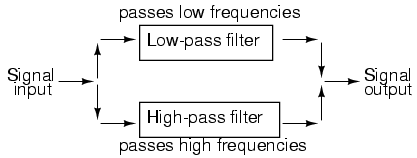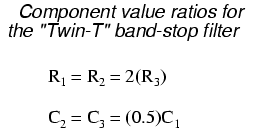Band-stop filters
Also called band-elimination,
band-reject, or notch filters, this kind of
filter passes all frequencies above and below a particular
range set by the component values. Not surprisingly, it can
be made out of a low-pass and a high-pass filter, just like
the band-pass design, except that this time we connect the
two filter sections in parallel with each other instead of
in series.

Constructed using two capacitive filter
sections, it looks something like this:

The low-pass filter section is comprised of
R1, R2, and C1 in a "T"
configuration. The high-pass filter section is comprised of
C2, C3, and R3 in a "T'
configuration as well. Together, this arrangement is
commonly known as a "Twin-T" filter, giving sharp response
when the component values are chosen in the following
ratios:

Given these component ratios, the frequency
of maximum rejection (the "notch frequency") can be
calculated as follows:

The impressive band-stopping ability of this
filter is illustrated by the following SPICE analysis:
twin-t bandstop filter
v1 1 0 ac 1 sin
r1 1 2 200
c1 2 0 2u
r2 2 3 200
c2 1 4 1u
r3 4 0 100
c3 4 3 1u
rload 3 0 1k
.ac lin 20 200 1.5k
.plot ac v(3)
.end
freq v(3) 1.000E-02 3.162E-02 1.000E-01 3.162E-01
- - - - - - - - - - - - - - - - - - - - - - - - - - - - - - - - -
2.000E+02 5.400E-01 . . . . *.
2.684E+02 4.512E-01 . . . . * .
3.368E+02 3.686E-01 . . . . * .
4.053E+02 2.946E-01 . . . *. .
4.737E+02 2.290E-01 . . . * . .
5.421E+02 1.707E-01 . . . * . .
6.105E+02 1.185E-01 . . . * . .
6.789E+02 7.134E-02 . . * . . .
7.474E+02 2.832E-02 . *. . . .
8.158E+02 1.126E-02 .* . . . .
8.842E+02 4.796E-02 . . * . . .
9.526E+02 8.222E-02 . . * . . .
1.021E+03 1.144E-01 . . . * . .
1.089E+03 1.447E-01 . . . * . .
1.158E+03 1.734E-01 . . . * . .
1.226E+03 2.007E-01 . . . * . .
1.295E+03 2.267E-01 . . . * . .
1.363E+03 2.515E-01 . . . * . .
1.432E+03 2.752E-01 . . . * . .
1.500E+03 2.980E-01 . . . *. .
- - - - - - - - - - - - - - - - - - - - - - - - - - - - - - - - -
-
REVIEW:
-
A band-stop filter works to screen
out frequencies that are within a certain range, giving
easy passage only to frequencies outside of that range.
Also known as band-elimination, band-reject,
or notch filters.
-
Band-stop filters can be made by placing a
low-pass filter in parallel with a high-pass filter.
Commonly, both the low-pass and high-pass filter sections
are of the "T" configuration, giving the name "Twin-T" to
the band-stop combination.
-
The frequency of maximum attenuation is
called the notch frequency.
|